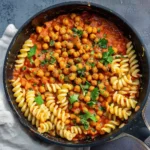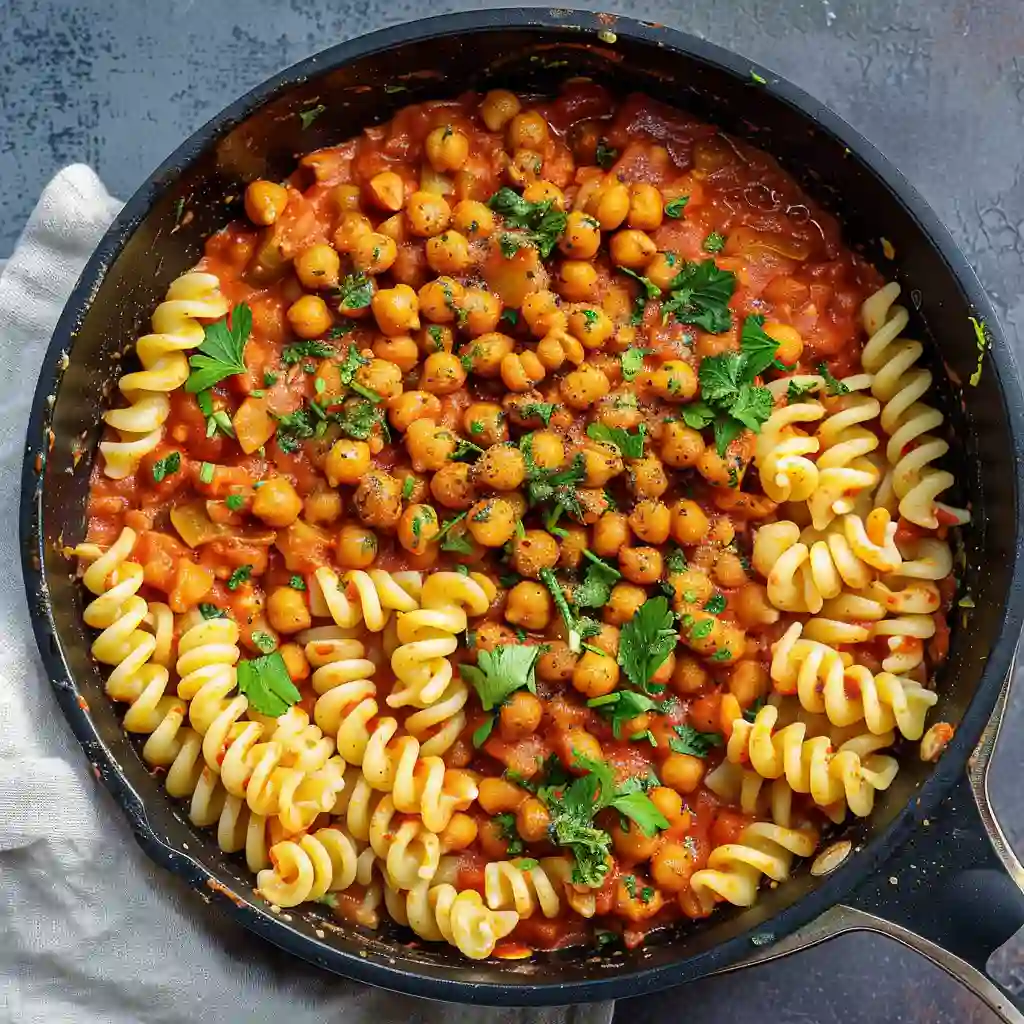The first time I made this Chickpea Paprikash, I was missing my grandmother’s cooking something fierce. Growing up, her traditional Hungarian paprikash with chicken was a staple at our family table—rich, comforting, and deeply flavored with that signature paprika warmth. After becoming more plant-based in my cooking, I spent weeks in my kitchen trying to capture those same soul-warming flavors without the meat.
It took several attempts (and many containers of paprika!) before I landed on this version. The chickpeas provide that perfect hearty texture while soaking up all the beautiful flavors of the sauce. Last Sunday, I served this to my neighbor who grew up in Budapest, and the smile that spread across her face told me everything I needed to know—I’d managed to honor the tradition while creating something new.
The Magic of Paprika
What makes this dish special isn’t complicated technique or rare ingredients—it’s understanding how to build layers of flavor around good-quality paprika. I’ve learned that giving the paprika a moment to bloom in the fat before adding the liquid ingredients makes all the difference. This simple step releases the full aromatic potential of the spice and eliminates any raw, dusty notes.
I’ve tested this recipe with both canned and home-cooked chickpeas, and honestly, good-quality canned ones work beautifully when you’re short on time (which, let’s be honest, is most weeknights in my house). The key is rinsing them well to remove any tinny flavor from the can.
What You’ll Need
Pasta: Any short pasta works wonderfully; I often use bowties or rotini since they catch the sauce so nicely. When photographing this dish for the blog, I’ve found that rigatoni creates the most beautiful presentation against my blue ceramic bowls.
Vegan butter: This adds richness to both the sauce and the finished pasta. I’ve tried using all olive oil, but the buttery notes really do make a difference in creating that silky finish.
Fresh parsley: Adds brightness and color to cut through the richness. I grab this straight from my windowsill herb garden.
Onion: The foundation of flavor in this dish. Take your time chopping it finely—those little bits will melt into the sauce creating a wonderful base.
Olive oil: Combined with the vegan butter, this creates the perfect fat base for blooming the paprika.
Tomato paste: Just a tablespoon creates depth without making the dish too tomato-forward. I’ve found that the tube varieties keep much better than canned for these small amounts.
Garlic powder: While I usually reach for fresh garlic, the powder works better here, dispersing evenly throughout the sauce without any harsh bits.
Sweet paprika: The star of the show! I use Hungarian sweet paprika when possible, but any good-quality sweet paprika works beautifully. The fresher your paprika, the more vibrant your sauce will be.
Chickpeas: They provide the hearty protein in this dish and absorb the flavors wonderfully.
All-purpose flour: Just a touch helps thicken the sauce to that perfect, silky consistency.
Vegetable broth: Creates the base of our sauce. I keep homemade in my freezer, but a good-quality store-bought works just fine.
Crushed tomatoes: Adds body and a gentle acidity to balance the richness.
Vegan sour cream: This creates the signature creamy tanginess that defines paprikash. I’ve tested several brands, and most work well here.
Red chili flakes: Entirely optional, but I love adding just a pinch for background warmth without making the dish spicy.
Let’s Get Cooking
Start With the Pasta
Cook your pasta according to the package directions in well-salted water. I always set a timer for 1 minute less than the package suggests for perfect al dente texture. Once drained, immediately toss with a tablespoon of vegan butter and the fresh parsley in a large bowl. This prevents sticking and begins layering flavor right away.
Build the Flavor Base
While the pasta cooks, start your sauce. In my favorite deep skillet (the blue enamel one that appears in so many of my kitchen photos), combine the onions, olive oil, remaining butter, salt, and pepper over medium heat. I’ve found that medium-low heat is crucial here—you want the onions to soften and become translucent without browning. Five minutes of gentle cooking creates the perfect foundation.
Create Depth
Next comes one of my favorite steps—adding the tomato paste and garlic powder. Stir constantly for about three minutes, allowing the tomato paste to caramelize slightly. You’ll notice the color deepen and the aroma intensify. This simple step transforms the flavor profile completely.
The Magic Happens
This is where the dish truly becomes paprikash. Stir in the paprika and chickpeas, coating everything in that gorgeous spice. Then quickly add the flour, stirring constantly to prevent any lumps. The flour will help create that silky texture that makes paprikash so comforting.
Bring It All Together
Pour in the vegetable broth, followed by the crushed tomatoes, vegan sour cream, and red chili flakes if using. Stir well to incorporate everything. This is when my kitchen fills with the most incredible aroma—earthy, sweet, and deeply savory. Let the sauce gently simmer for 4-5 minutes, being careful not to let it boil, which could cause the cream to separate.
The Final Touch
Fold your pasta into the sauce, ensuring every piece gets coated in that beautiful paprika-rich sauce. I like to serve this straight from the pan at my table, family-style, with extra parsley sprinkled on top.
Make It Your Own
Over the countless times I’ve made this dish, I’ve played with several variations that have become favorites in my kitchen:
When I’m craving extra vegetables, I add a diced red bell pepper along with the onions, which echoes the paprika’s sweet notes while adding beautiful color and nutrition.
For dinner parties, I’ve served this over creamy mashed potatoes instead of pasta, which creates an even more comforting dish that reminds me even more of my grandmother’s cooking.
Last winter, when I had beautiful mushrooms from the farmers market, I added 8 ounces of sliced cremini mushrooms right after the onions softened. The earthiness pairs wonderfully with the paprika.
My Best Tips
After making this dish countless times, I’ve learned that the order of ingredients truly matters. Adding the paprika after the tomato paste has caramelized but before adding liquids prevents it from becoming bitter while allowing its flavors to bloom.
Don’t rush the sauce-building steps. Those first 8-10 minutes of gentle cooking create the foundation for the entire dish.
If your sauce ever looks like it might separate after adding the vegan sour cream, immediately remove it from the heat and whisk vigorously until smooth again.
For the most vibrant color and flavor, check the freshness of your paprika—if it’s been sitting in your cabinet for more than a year, consider replacing it before making this dish.
Frequently Asked Questions
Can I use smoked paprika instead of sweet? → While traditional paprikash uses sweet paprika, I’ve made it with half sweet and half smoked paprika when I want a deeper, more complex flavor. Just don’t use all smoked or it overpowers the dish.
Is there a substitute for vegan sour cream? → I’ve successfully used plain coconut yogurt in a pinch. The flavor is slightly different but still delicious.
How long does this keep in the refrigerator? → The sauce keeps beautifully for up to 4 days. I recommend storing the pasta separately if possible, but it’s still delicious even combined.
Can I freeze this dish? → The sauce freezes well without the pasta for up to 3 months. The texture of the chickpeas changes slightly but remains delicious.
What can I serve with this? → A simple green salad with a light vinaigrette creates the perfect balance to the rich, creamy paprikash. I also love serving it with quick-pickled cucumbers for a tangy contrast.
Print
Chickpea Paprikash
- Total Time: 30 minutes
- Yield: 4 servings 1x
Description
A creamy, comforting plant-based twist on traditional Hungarian paprikash using protein-rich chickpeas instead of meat. This vibrant dish combines smoky paprika with tangy tomatoes and vegan sour cream for a satisfying meal that comes together quickly.
Ingredients
- 1/2 lb. pasta
- 2 tbsp vegan butter, divided
- 3 tbsp finely chopped fresh parsley
- 1 cup finely chopped onion
- 2 tbsp olive oil
- 1 tsp kosher salt
- 1/2 tsp black pepper
- 1 tbsp tomato paste
- 1 tsp garlic powder
- 2 tbsp sweet paprika
- 2 15 oz. cans chickpeas, drained and rinsed
- 1 tbsp all-purpose flour
- 1 cup vegetable broth
- 2 cups crushed tomatoes
- 1/2 cup vegan sour cream
- 1/8 to 1/4 tsp red chili flakes (optional)
Instructions
- Cook the pasta: Cook pasta according to package directions for al dente in salted water (2 tbsp kosher salt), then drain. Transfer pasta to large mixing bowl, add 1 tbsp butter & fresh parsley. Toss to coat the pasta evenly, which will prevent it from sticking while you prepare the sauce.
- Sauté the aromatics: Meanwhile, over medium heat, add onions, oil, remaining butter, salt & pepper to pan. Stir, cook on medium low heat for 5 minutes until the onions become translucent and slightly softened. This forms the flavor base of your dish.
- Build the flavor base: Add tomato paste & garlic powder. Stir, cook 3 minutes to caramelize the tomato paste slightly, which deepens the overall flavor of the dish and removes any raw tomato taste.
- Create the sauce: Stir in paprika & chickpeas. Then stir in the flour, which will help thicken your sauce. Stir in vegetable broth followed by crushed tomatoes, sour cream & optional red chili flakes. Stir well to incorporate. Bring to gentle simmer, cook for 4-5 minutes, careful not to boil as this can cause the vegan sour cream to separate. Add pasta and serve immediately.
Notes
- Hungarian paprikash traditionally uses chicken, but chickpeas make an excellent plant-based protein substitute.
- For best results, use high-quality sweet paprika, as it’s the star flavor in this dish.
- The dish can be made gluten-free by using gluten-free pasta and substituting the all-purpose flour with cornstarch or rice flour.
- Leftovers can be stored for up to 3 days in the refrigerator. The sauce may thicken; thin with a little vegetable broth when reheating.
- For added depth, you can add 1/2 teaspoon of smoked paprika along with the sweet paprika.
- Prep Time: 10 minutes
- Cook Time: 20 minutes
- Category: Main-course
- Method: One Pot & One Pan
- Cuisine: Hungarian-inspired
Nutrition
- Serving Size: 1/4 of recipe
- Calories: 480g
- Sugar: 12g
- Sodium: 890mg
- Fat: 16g
- Saturated Fat: 3g
- Unsaturated Fat: 12g
- Trans Fat: 0g
- Carbohydrates: 70g
- Fiber: 13g
- Protein: 16g
- Cholesterol: 0mg


